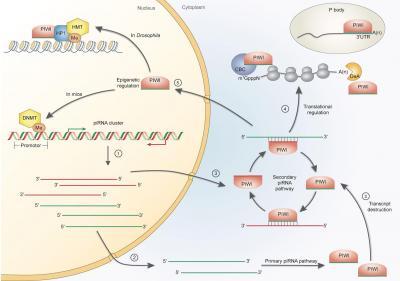Non-coding RNAs represent one of the most exciting aspects of current biomedical research. Non-coding RNAs include long non-coding RNAs (lncRNAs) which are generally longer than 200 nucleotides (nt) and small non-coding RNAs (sncRNAs) that are mostly 20-35 nt. Among sncRNAs, microRNAs (miRNAs) and small interfering RNAs (siRNAs) are commonly 21 nt in length, and both specifically bind to the AGO subfamily of the ARGONAUTE (AGO)/PIWI family proteins. PIWI-interacting RNAs (piRNAs), which are defined by their specific binding to the PIWI subfamily of AGO/PIWI family proteins, are mostly 24-32 nt in length. The piRNAs exist, in millions of species, in a multicellular organism and are most abundant in the germline. Furthermore, piRNAs correspond to all types of genomic sequences such as gene-coding and intergenic regions. These two features endow piRNAs with a salient role in regulating gene expression during germline development.
These fascinating features of piRNAs are now reviewed in an article entitled "PIWI proteins and their interactors in piRNA biogenesis, germline development and gene expression" in the Beijing-headquartered journal National Science Review. The article includes an introduction to PIWI proteins, the major PIWI-interactors, and their roles in piRNA biogenesis. The review also covers the regulatory function of the PIWI-piRNA pathway in the germline and in the recently reported somatic tissues.
Haifan Lin, the corresponding author of the article, is a professor of cell biology, of genetics and of reproductive sciences at Yale University, and is the director of the Yale Stem Cell Center. Co-author Hsueh-Yen Ku is a post-doctoral research fellow at Yale.
"Current research also provides evidence that PIWI proteins and piRNAs … mediate novel mechanisms of epigenetic programming, DNA rearrangements, mRNA turnover, and translational control both in the germline and in the soma," the co-authors state in the National Science Review article. "These new discoveries begin to reveal an exciting new dimension of gene regulation in the cell."
PIWI proteins have been demonstrated to be essential for germline development across species.
PIWI mutations in Drosophila, C. elegans, mice, and zebrafish cause gametogenic defects such as failure in germline establishment, loss of germline stem cells (GSCs), meiotic arrest, and blockage in spermiogenesis, all of which lead to sterility. Recent studies have identified PIWI-interacting proteins, including many members of the TUDOR protein family, and have revealed that these PIWI-interactors exhibit similar mutant phenotype as piwi.
Furthermore, PIWI proteins and these PIWI-interactors are required for the primary pathway and/or the ping-pong cycle of piRNA biogenesis. Because piRNAs are derived from the RNA transcripts of transposons, protein-coding genes, and specific intergenic loci, piRNAs are thought to act as sequence-specific guides of PIWI proteins to regulate the expression of genes and transposons at both transcriptional and post-transcriptional levels (see figure below).
Recent efforts in studying the piRNA pathway in non-germline tissues such as neurons and cancer cells have led to the discovery of PIWI somatic funcitons. Therefore, the scope of PIWI-piRNA studies has been significantly expanded from the germline to the soma, with a focus on not only transposon silencing but also gene regulation during normal development and tumoriogenesis.

(adapted from Ku and Lin, National Science Review)
PIWI proteins and piRNAs regulate the expression of genes and transposons at both transcriptional and post-transcriptional levels. (1) Sense and antisense piRNA precursor transcripts are produced from piRNA clusters in the nucleus. (2) Antisense piRNA precursor transcripts are transported to the cytoplasm and processed by the primary biogenesis pathway to generate mature sense piRNAs that associate with PIWI proteins. (3) The PIWI-antisense piRNA complexes mediate cleavage of sense piRNA precursors and transposon (and protein-coding) transcripts, which silence transposon and gene expression at the post-transcriptional level. The resulting sense transcripts are taken up by PIWI proteins responsible for sense piRNA binding. The PIWI-sense piRNA complexes then cleave antisense piRNA precursor transcripts to amplify the piRNA biogenesis cycle (the ping-pong cycle). (4) The PIWI-piRNA complexes are involved in translational regulations by interacting with polysomes, mRNA cap-binding complex (CBC, in mice), and mRNA deadenylase (DeA, in Drosophila). In addition, the PIWI-piRNA complexes are associated with P-body components and piRNAs are mapped to the 3′UTR of mRNAs. (5) The PIWI-piRNA complexes can enter the nucleus and regulate gene transcription through epigenetic mechanisms including heterochromatin formation and DNA methylation in the promoter region of target genes. 3′UTR, 3' untranslated region; CBC, cap-binding complex; DeA, deadenylase; DNMT, DNA methyltransferase; HMT, histone methyltransferase; HP1, heterochromatin protein 1; Me, methylation.
(Photo Credit: ©Science China Press)
Source: Science China Press